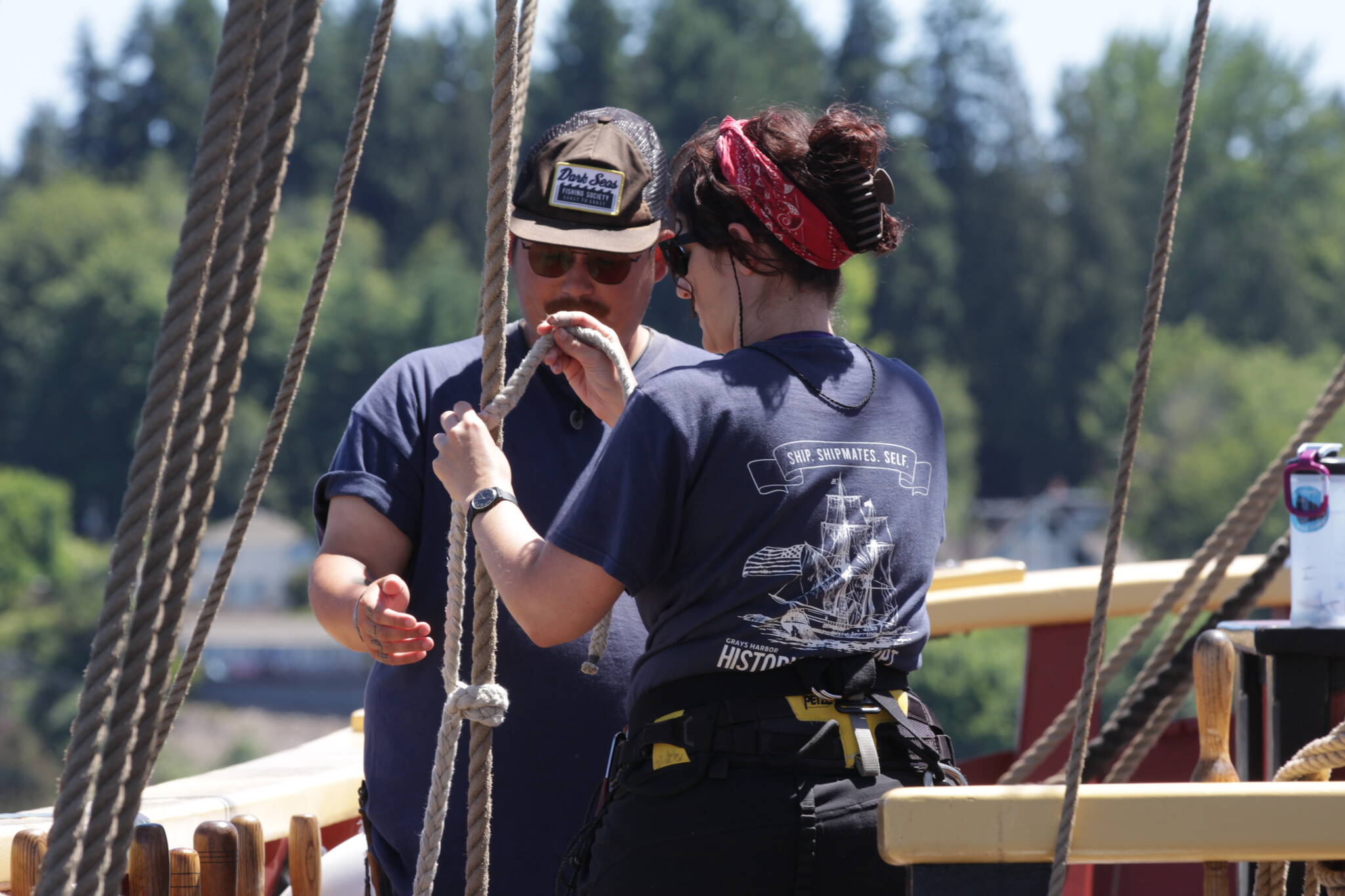A few marine archaeologist graduate students aboard the Lady Washington this summer will learn about sailing — not from studying ancient shipwrecks and historical accounts but from the most timeless and effective way of learning anything — by doing.
“So this is a training program for maritime history and nautical archaeological specialists,” said Annaliese Dempsey, a program instructor for the SAIL program — Sailing and Archaeological Integrated Learning. “I’m training people who are going to be in the field of nautical archeology.”
Four students, currently all Texas A&M University graduate students, are spending two weeks aboard the ship homeported in Aberdeen, learning terminology, hauling lines, climbing the rigging and sleeping aboard as they learn about what it’s like to actually sail, in order to help guide their future studies by teaching them the right questions to ask.
“It gives us insight that allows us to ask better research questions,” Dempsey said. “You can’t know what you don’t know.”
That insight is key as students look toward the future, allowing them to better utilize information and resources they may already have, said Marijo Gauthier-Bérubé, coming from Montreal, who earned her doctorate from the program studying shipwrecks in France.
“It gives you a pretty good idea of how it might have looked like,” Gauthier-Bérubé said. “It’s also bringing a new perspective on the sources I can use.”
The vessel’s captain, Capt. Katherine Pogue, said she was well pleased with the students and their progress.
“Oh, man. They’re so great, so enthusiastic,” Pogue said. “They’re learning a lot so quickly.”
All hands together now
Some knowledge, such as how the rigging and the sails aboard a ship work, are just much easier to teach in an environment like a working ship as opposed to the detached theoreticals of the academic environment, Dempsey said.
“Learning a rig like this is just impossible in a classroom setting. This is a machine that works in four dimensions,” Dempsey said. “How do you put that on a chalkboard?”
The difference between knowing how it works and actually seeing it in action is substantial, Dempsey said.
“It’s been awesome. We take a rigging class and we learn everything about the rig and names and kind of what they do,” said Patrick Boyle, a student in the Nautical Archeology Program. “But actually being here and putting hands on the rigging and putting it all together is something you can’t conceptualize in a class.”
It also gives students a chance to think about the language of sailing, which is already shot through with words with different meaning or altogether absent from everyday English, Dempsey said.
“Marijo’s native language is French,” Dempsey said. “It’s caused us to think about the sailing language in a different way.”
Boyle said that getting used to the commands was formidable at first.
“It’s pretty intimidating at first,” Boyle said. “It starts making sense. You know where to go and what to do.”
Hull above water
The salt water of the sea is hungry for organic material, particularly to masts and rigging, which deteriorate after years on the bottom, Dempsey said.
“Usually the things above deck don’t preserve very well at wreck sites,” Dempsey said. “We’re already a step behind for that type of knowledge.”
Many of the students haven’t seen and interacted with intact vessels, Dempsey said, only working closely with ships that have already gone to the bottom.
“They’ve got a lot of the boat anatomy but they’ve only ever seen it if the ship is wrecked, which is a little different,” Dempsey said. “They’ve seen it in documents. But not the three-dimensional structure.”
A former crewmember of the Lady Washington, Dempsey said the vessel is an ideal training platform for new sailors.
“I wanted to do this specially with Lady Washington for a couple reasons. Her rig type is very good for teaching,” Dempsey said. “She’s a relatively small brig. It’s relatively easy to see everything that’s happening. So when they’re studying this they know the balance of physics that’s required to operate it. She’s relatively nimble. I’m a little biased but I think she’s really fun to sail.”
She expected going aloft to be a bigger issue, Gauthier-Bérubé said. Instead, Gauthier-Bérubé said she became comfortable with it more quickly than expected.
“My biggest surprise, I thought I would be more afraid, to cry in the rig,” Gauthier-Bérubé said. “I thought I would be shaking and not be comfortable and want to go back as soon as possible.”
Public and future facing
The students have also been giving presentations to visitors who come aboard, talking about their specialty, which is another opportunity to train, Dempsey said.
“We don’t have a lot of opportunities to communicate that research to the public, which is ostensibly the whole point,” Dempsey said. “You need to figure out how to make your research relevant to the public, and not only relevant but meaningful.”
Dempsey hopes to see the program formally integrated into the university’s nautical archeology program, she said. Bringing graduate students together with sailors will benefit both, Dempsey said.
“I think the other big thing is tall ship sailors and maritime archaeologists are very niche communities. They’re very separate,” Dempsey said. “I’m very excited about the possibility of creating overlap and creating communication. They both have this deep font of knowledge.”
It’s an ideal union, Gauthier-Bérubé said.
“I think this is an amazing experience,” Gauthier-Bérubé said. “I think books are important but experience is important as well. This is the perfect meeting of those two aspects.”
Dempsey said she also hopes to see the program grown to other colleges.
“I would like to expand it to other groups of people,” Dempsey said. “Texas A&M doesn’t have the only maritime history program.”
Contact Senior Reporter Michael S. Lockett at 757-621-1197 or mlockett@thedailyworld.com.



